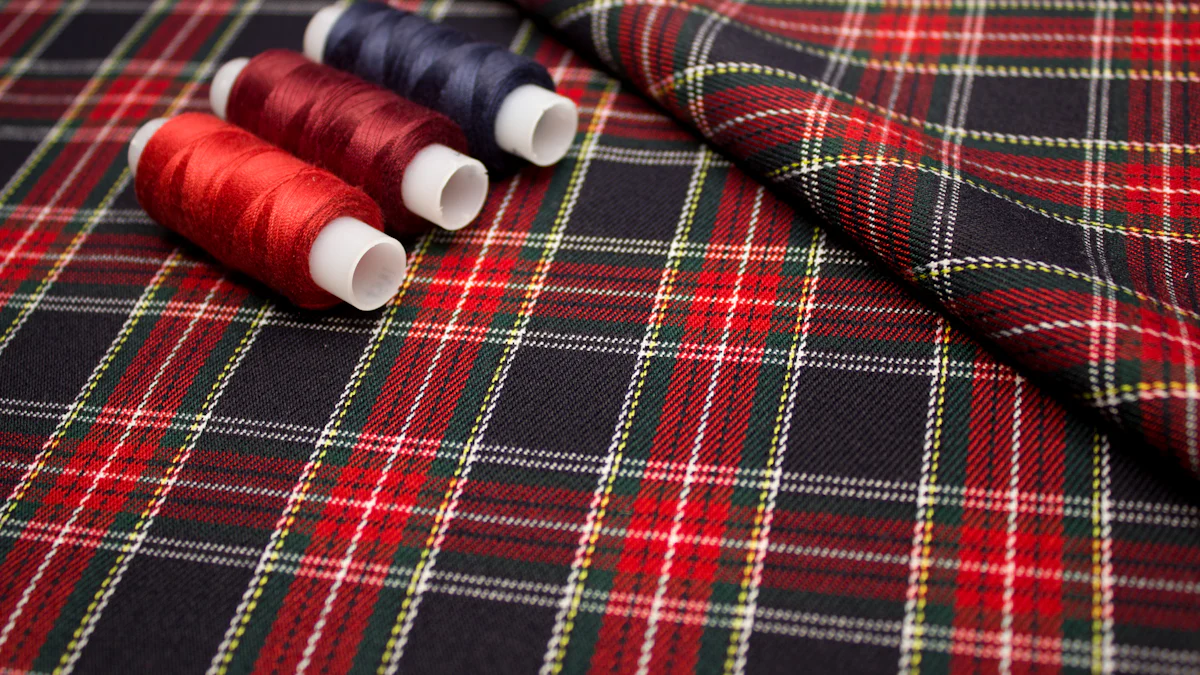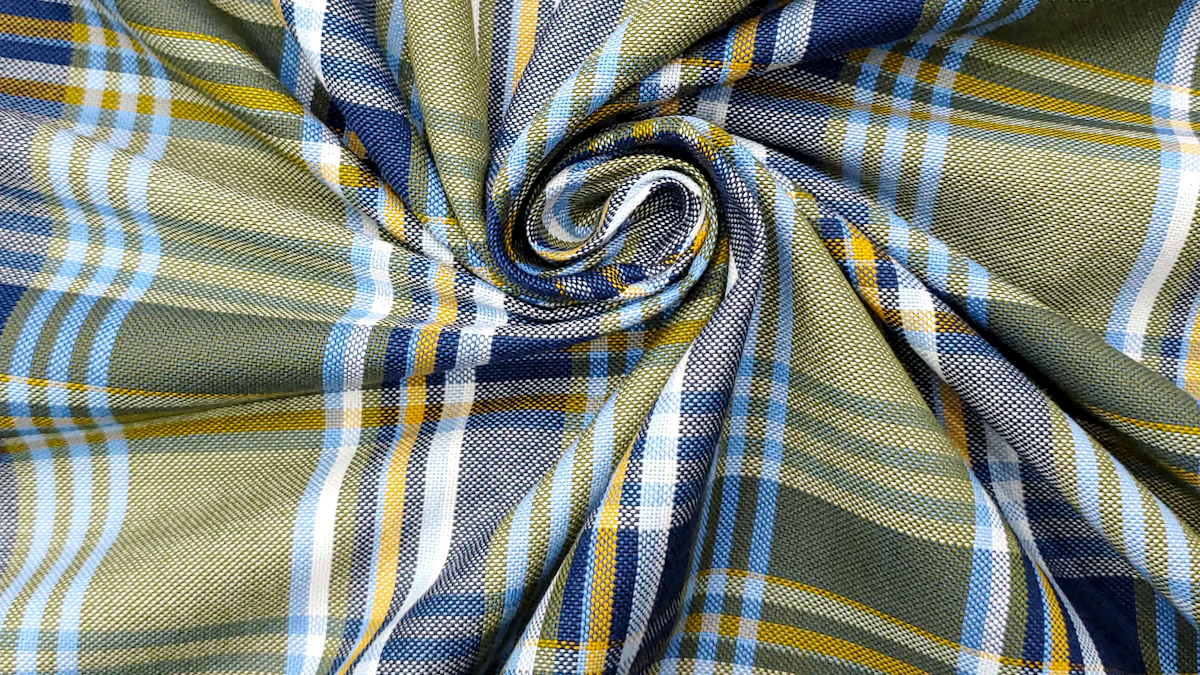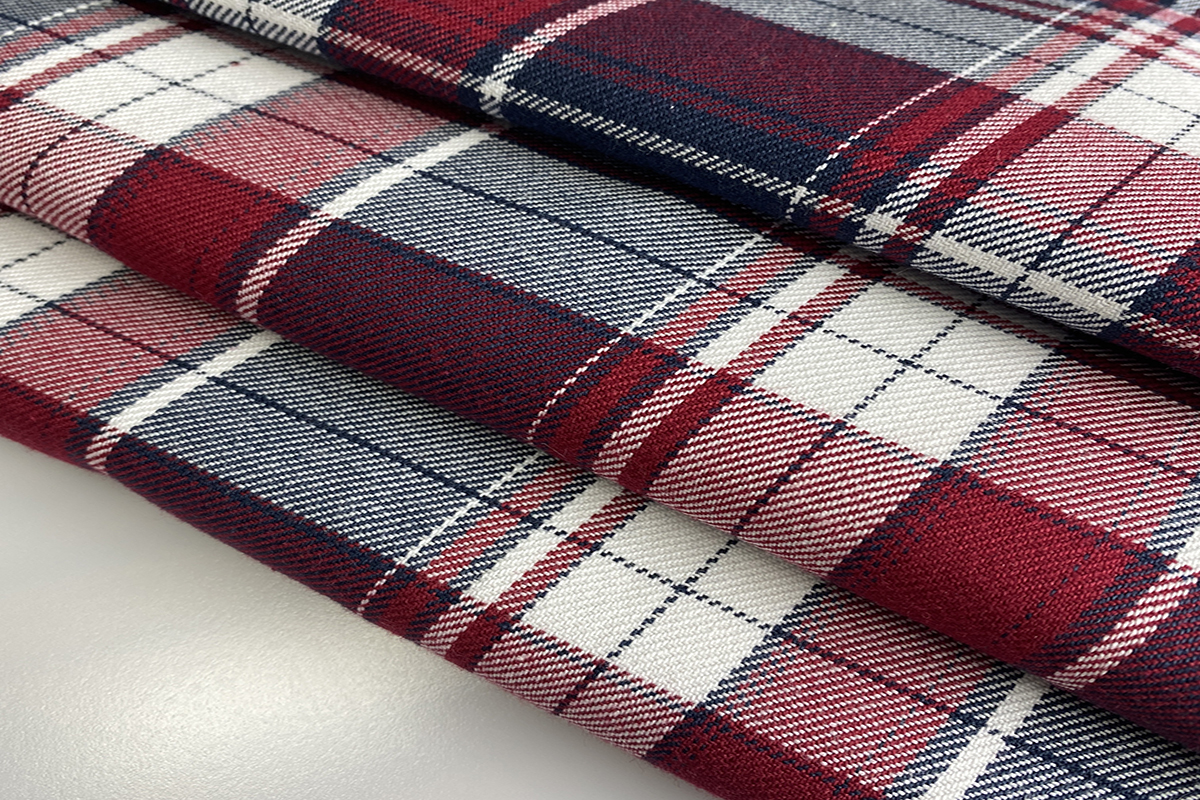
Selecting the perfect school fabric is essential to keep students comfortable and confident all day long. Polyester rayon plaid fabric is an excellent choice due to its durability and easy care, making it ideal for school plaid fabric needs. This versatile material is particularly well-suited for jumper fabric and school skirt fabric, as it withstands the demands of daily wear. Whether you’re looking for a reliable school fabric or a stylish yet practical option, polyester rayon plaid fabric delivers on all fronts.
Key Takeaways
- Polyester rayon plaid fabric lasts long and is simple to clean. It works well for school uniforms used every day.
- Cotton blends are soft and let air through. They are good for hot weather and comfy for long school hours.
- When picking fabric for uniforms, think about how strong it is, how easy it is to clean, and the weather. This helps meet students’ needs.
Material Overview

Polyester Rayon Plaid Fabric Composition
Polyester rayon plaid fabric combines two synthetic fibers: polyester and rayon. Polyester provides strength and resistance to wear, while rayon adds a soft handfeeling and enhances the fabric’s drape. This blend creates a material that balances durability with comfort. The plaid design is woven into the fabric, ensuring patterns remain vibrant and intact even after repeated washes. I find this composition particularly effective for school uniforms, as it resists wrinkles and maintains its structure throughout the day. Its ability to handle the rigors of daily school activities makes it a dependable choice for jumpers and skirts.
Characteristics of Cotton Blends
Cotton blends, especially poly-cotton, are widely used in school uniforms. These blends combine cotton’s natural softness with polyester’s durability. Key features include:
- Poly-cotton blends offer a balance of comfort and strength.
- Polyester content reduces shrinkage and enhances wrinkle resistance.
- These blends are more affordable than pure cotton or polyester fabrics.
I appreciate how these blends cater to both comfort and practicality. They feel soft against the skin, making them suitable for long school days. Additionally, their cost-effectiveness makes them a popular choice for schools working within tight budgets.
Key Differences in Fabric Properties
Polyester rayon plaid fabric and cotton blends differ in several ways. Polyester rayon offers superior wrinkle resistance and a smoother texture, while cotton blends excel in breathability and natural softness. Polyester rayon is more durable, making it ideal for high-activity environments. Cotton blends, however, provide a more traditional feel and are better suited for warmer climates. When choosing between the two, I recommend considering the specific needs of the school environment, such as climate and activity levels.
Durability Comparison
Durability of Polyester Rayon Plaid Fabric
Polyester rayon plaid fabric stands out for its exceptional durability. I have observed that this fabric resists wear and tear, even with daily use. Its polyester component provides strength, ensuring the material holds up well under the stress of active school environments. The rayon adds a soft handfeeling, but it does not compromise the fabric’s resilience. This combination makes it ideal for school uniforms like jumpers and skirts, which often endure frequent washing and heavy use. Additionally, the woven plaid design remains intact over time, maintaining its vibrant appearance. I find this fabric particularly reliable for schools seeking long-lasting uniform solutions.
Durability of Cotton Blends
Cotton blends, especially poly-cotton, offer a balance of durability and comfort. The polyester content enhances the fabric’s strength, reducing the likelihood of shrinkage or damage during washing. However, I have noticed that cotton blends may not withstand the same level of wear as polyester rayon plaid fabric. Over time, the cotton fibers can weaken, especially with repeated exposure to harsh washing conditions. Despite this, poly-cotton blends remain a cost-effective option for schools, providing adequate durability for less demanding environments.
Best Choice for Daily School Wear
For daily school wear, polyester blends emerge as the most economical and practical choice. Their durability and minimal maintenance requirements reduce the need for frequent replacements, making them highly suitable for school uniforms. Polyester rayon plaid fabric, in particular, excels in resisting wear and frequent washing, ensuring it meets the demands of active school settings. While poly-cotton blends offer a balance of durability and comfort, they may not match the long-term resilience of polyester rayon. Based on my experience, I recommend polyester rayon plaid fabric for schools prioritizing durability and reliability in their uniforms.
Comfort and Breathability
Comfort of Polyester Rayon Plaid Fabric
I find polyester rayon plaid fabric to be a comfortable option for school uniforms. The rayon component gives the material a soft handfeeling, making it gentle against the skin. This softness ensures students remain comfortable throughout the day, even during long hours of wear. The fabric also drapes well, which enhances the overall fit and appearance of uniforms like jumpers and skirts. While polyester adds durability, it does not compromise the fabric’s smooth texture. In my experience, this blend strikes an excellent balance between comfort and practicality, making it a reliable choice for active school environments.
Comfort of Cotton Blends
Cotton blends, particularly poly-cotton, excel in providing natural comfort. The cotton content offers a soft and breathable texture, which feels pleasant on the skin. I have noticed that these blends are especially suitable for students in warmer climates, as they help regulate body temperature. However, the polyester component in poly-cotton blends slightly reduces the natural softness of pure cotton. Despite this, the overall comfort level remains high, making these blends a popular choice for school uniforms.
Breathability Analysis
Breathability plays a crucial role in determining fabric suitability for school uniforms. Cotton blends outperform polyester rayon plaid fabric in this aspect. The natural fibers in cotton allow better air circulation, keeping students cool during physical activities or in hot weather. Polyester rayon, while less breathable, compensates with its moisture-wicking properties. This feature helps manage sweat, ensuring students stay dry and comfortable. Based on my observations, cotton blends are ideal for schools in warmer regions, while polyester rayon plaid fabric works well in moderate climates.
Maintenance and Care
Cleaning and Maintenance of Polyester Rayon Plaid Fabric
Polyester rayon plaid fabric requires minimal effort to maintain. I have found that this fabric can be machine-washed without special precautions, making it a practical choice for busy households. Its wrinkle-resistant nature eliminates the need for frequent ironing, saving time and effort. Tumble-drying on low heat works well for this material, as it resists shrinkage and maintains its structure. I recommend using a gentle detergent to preserve the fabric’s vibrant plaid patterns. This blend’s durability ensures it withstands repeated washing without losing its soft handfeeling or shape.
Cleaning and Maintenance of Cotton Blends
Cotton blends demand slightly more attention during cleaning. I always advise washing these fabrics at cooler temperatures to prevent shrinkage and maintain their integrity. Air drying works best for cotton-rich blends, as tumble-drying may weaken the natural fibers over time. Ironing requires low to moderate heat to avoid damaging the fabric. While these blends offer a soft and breathable texture, their maintenance routine can feel more time-consuming compared to synthetic options. Proper care ensures the fabric retains its comfort and appearance for longer periods.
Which Fabric is Easier to Care For?
Polyester rayon plaid fabric stands out as the easier option to care for. Its synthetic composition allows for machine washing and tumble-drying without the risk of shrinkage or damage. Cotton blends, while comfortable, require more careful handling, including air drying and precise ironing. For schools and parents seeking low-maintenance uniforms, I recommend polyester rayon plaid fabric. Its durability and ease of care make it a reliable and time-saving choice for daily use.
Cost and Affordability
Price Comparison
Polyester rayon plaid fabric stands out as the most cost-effective option for school uniforms. Its synthetic composition allows manufacturers to produce it at a lower cost compared to cotton blends. Cotton, being a natural fiber, tends to be more expensive due to its cultivation and processing requirements. I have observed that schools often choose polyester blends for their affordability and durability, especially when managing tight budgets. This makes polyester rayon plaid fabric an excellent choice for schools seeking high-quality uniforms without overspending.
Value for Money
When evaluating long-term value, polyester rayon plaid fabric consistently delivers better results. Its durability and low-maintenance qualities reduce the need for frequent replacements. I have noticed that this fabric resists wrinkles and stains, maintaining a polished appearance even after multiple washes. Cotton blends, while offering superior comfort and breathability, require more care. They wrinkle easily and may shrink if not washed properly. Over time, these maintenance needs can increase costs for families. For schools prioritizing longevity and cost-efficiency, polyester rayon plaid fabric provides unmatched value.
Budget-Friendly Options for Schools
Schools often seek fabrics that balance affordability with performance. Polyester and poly-cotton blends are the most budget-friendly options available. Polyester rayon plaid fabric excels in durability and low maintenance, reducing the need for frequent replacements. It resists wrinkles and stains, ensuring uniforms look neat throughout the school year. Poly-cotton blends combine the strength of polyester with the comfort of cotton, offering a practical alternative. Both options provide long-lasting value, but I recommend polyester rayon plaid fabric for schools aiming to minimize costs while maintaining quality.
Suitability for School Uniforms
 Polyester Rayon Plaid Fabric for School Uniforms
Polyester Rayon Plaid Fabric for School Uniforms
Polyester rayon plaid fabric offers several advantages that make it an excellent choice for school uniforms. Based on my experience, this fabric excels in durability, comfort, and affordability. Its ability to resist wrinkles and stains ensures that uniforms maintain a polished appearance throughout the school day. I have found that this fabric is particularly well-suited for active students who require clothing that can withstand frequent washing and daily wear. Below is a summary of its key benefits:
| Advantage | Description |
|---|---|
| Durability | Polyester rayon plaid fabric is known for its exceptional durability, making it ideal for active students. |
| Low Maintenance | The fabric resists wrinkles and stains, ensuring uniforms maintain a polished appearance. |
| Comfort | Blended fabrics like poly-cotton offer softness and breathability for all-day wear. |
| Cost-Effectiveness | Polyester blends provide a practical solution for families seeking affordability. |
This combination of features makes polyester rayon plaid fabric a dependable option for schools aiming to balance quality and cost.
Cotton Blends for School Uniforms
Cotton blends, especially poly-cotton, also perform well as school uniform fabrics. I appreciate their ability to combine the natural softness of cotton with the resilience of polyester. These blends provide a balance of comfort and durability, which is essential for students during long school days. Key characteristics include:
- Cotton blends offer natural softness and breathability, ensuring student comfort.
- The polyester component enhances durability and reduces shrinkage.
- These fabrics are versatile and suitable for various climates, especially warmer regions.
While cotton blends require more care during washing and ironing, they remain a popular choice for families who prioritize comfort and traditional fabric textures.
Final Recommendation for School Plaid Fabric
When choosing between polyester rayon plaid fabric and cotton blends, I recommend considering factors such as durability, maintenance, and climate suitability. Polyester rayon plaid fabric stands out for its exceptional durability, low maintenance, and cost-effectiveness. It is ideal for schools in moderate climates and for students with active lifestyles. Cotton blends, on the other hand, excel in breathability and comfort, making them better suited for warmer regions. Based on my analysis, polyester rayon plaid fabric is the superior choice for most school uniform needs due to its long-lasting performance and practicality.
Polyester rayon plaid fabric and cotton blends each offer unique advantages.
- Polyester Rayon Plaid Fabric Strengths:
- Durability: Exceptional strength for heavy use.
- Comfort: Soft handfeeling for all-day wear.
- Maintenance: Wrinkle-resistant and easy to clean.
- Cost: Budget-friendly with long-lasting value.
| Cotton Blend Strengths | Description |
|---|---|
| Durability | Strong and resistant to wear, ideal for uniforms. |
| Comfort | Soft and breathable, perfect for hot weather. |
| Maintenance | Easy to wash and retains quality. |
| Cost | Affordable due to reduced production costs. |
I recommend polyester rayon plaid fabric for its resilience and low maintenance, ideal for active students. Cotton blends suit warmer climates with their breathability and comfort. Both options balance quality and affordability, but polyester rayon plaid fabric excels in meeting the demands of school uniforms.
FAQ
What makes polyester rayon plaid fabric ideal for school uniforms?
Polyester rayon plaid fabric offers durability, wrinkle resistance, and a soft handfeeling. It withstands daily wear and frequent washing, making it perfect for active students.
Are cotton blends suitable for colder climates?
Cotton blends work better in warmer climates due to their breathability. For colder regions, polyester rayon plaid fabric provides better insulation and retains warmth effectively.
How do I maintain the vibrant plaid patterns on uniforms?
I recommend using gentle detergents and washing polyester rayon plaid fabric in cold water. Avoid harsh chemicals to preserve the fabric’s vibrant plaid design.
Post time: Jan-18-2025
